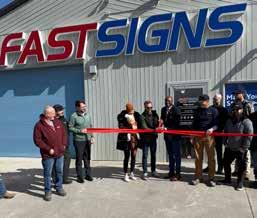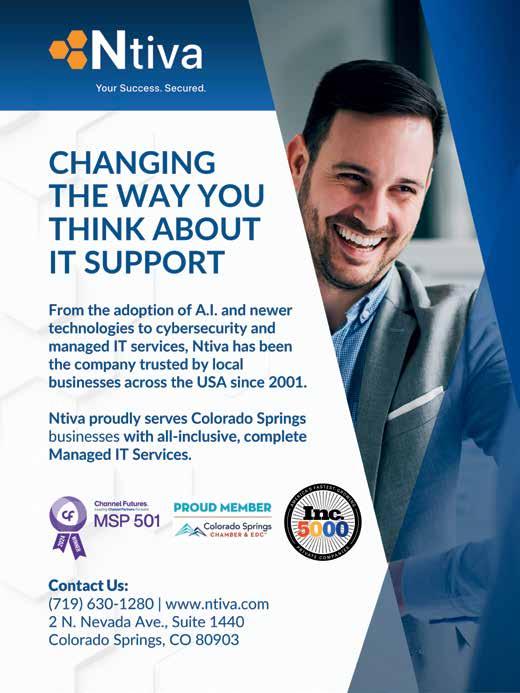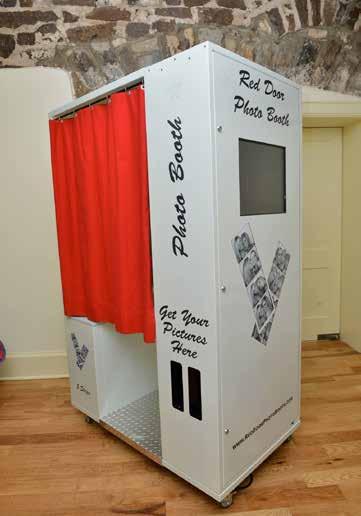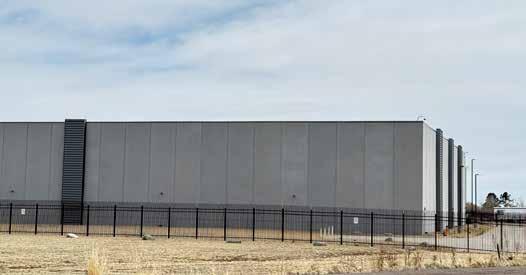Downtown upsides



By ANDREW ROGERS • andrew.rogers@ppmc.live
Downtown Colorado Springs is made up of just 120 city blocks
(or less than 1% of the city’s land mass) but played host to 16.2 million people in 2024. More than 12.3 million of those were visitors from outside of the area. Around 3.2 million people commute in and out of downtown each day to work, while the area is home to 630,000 residents.
“Are there challenges? Yes. Are macroeconomic conditions challenging? Absolutely. Do we struggle with issues such as homelessness? Of course, we do — all downtowns do. Is downtown losing the battle as a result of these challenges? Absolutely not,” Hannah Parsons said to
a group of stakeholders, elected officials and downtown business owners on March 20 as the Downtown Partnership presented the annual State of Downtown report.
Parsons is the interim president and CEO of the Downtown Partnership. The downtown Colorado Springs development authority is tasked with promoting not only the economic growth, but also the physical growth of downtown Colorado Springs, a one-square-mile area bordered by Cache La Poudre Street to the north, Fountain Boulevard to the south, Sierra Madre to the west and Wahsatch to the east. NEW
Colorado Springs marijuana businesses prepare for new customer base





PUBLISHER
Francis J. Zankowski
EDITOR IN CHIEF
Ben Trollinger
MANAGING EDITOR
Andrew Rogers
CONTRIBUTORS
Tatiana Bailey, Ph.D.
Jim Flynn
Bruce Gillies, PsyD.
Abe Lipson
AD DIRECTOR
Karen Hazlehurst
ACCOUNT EXECUTIVES
Monty Hatch
Sidney Fowler
Jacob Lonergan
Carla Wink
AD COORDINATOR
Lanny Adams
SENIOR EDITORIAL DESIGNER
Adam Biddle
DIGITAL/SOCIAL MEDIA STRATEGIST
Sean Cassady
DISTRIBUTION MANAGER
Kay Williams
Mail 422 East Vermijo Ave. Colorado Springs, CO 80903
Web www.CSBJ.com
Tips csbj@ppmc.live
Editor editor@ppmc.live
Advertising advertising@ppmc.live
Distribution distribution@ppmc.live
Publisher publisher@ppmc.live Subscribe. Sign up for our daily newsletter.


andrew.rogers@ppmc.live
It seems to be a major goal for many these days to obtain some halcyon level of work/life balance. There seems to be more pressure than ever these days on both sides of the equation. We feel driven and pushed to perform in the upper echelons at work. Meanwhile, we’re also asked to flip the proverbial switch to instantaneously become the best parent, partner or friend that we can — all while leaving no room for compromise between the two. As a fan of the TV show “Severance,” it would be easy to see the benefit of having that fictional chip inserted into my brain and finding a way to fully separate the “work me” from the “home me.” Instead, the pressures of home life and work life continue to battle within, much like high and low fronts do during the summer storm season, often resulting in a thunderstorm of emotions and a feeling of letting someone down in the process.
The cold truth is that there is no real reprieve from either of these two pressures. Mrs. Rogers and the kids can empathize with the pressures at work, but do not put their need for my time aside. The work equivalent can be said for my boss.
I’ll go out on a limb and argue that I’m not the only one who is caught between the proverbial rock and hard place. Just like resumes are formed and developed by our past, it’s fair to say that our workplace success is also tied to being able to recharge our batteries outside of the office.
Like it or not, there are only 24 hours in a day and — despite what The Beatles said — only seven days in a week. Doing some quick math, the day can be split up into three eight-hour sections. One of those blocks is used for sleep (the doctors recommend eight hours of beauty rest, but few get that). That leaves two eight-hour
sections available — in a perfect world — to be split between work and home. But what do we do when the two inevitably begin to intersect with each other?
If we keep spending more and more time at work, we’ll end up like Jack Nicholson in “The Shining”: “All work and no play makes Jack a dull boy.” On the other side, if “life” starts to intersect too much, we’ll be seen — rightfully or not — as unreliable and could be overlooked for promotion opportunities or, even worse, headed
“ The cold truth is that there is no real reprieve from either of these two pressures. Mrs. Rogers and the kids can empathize with the pressures at work, but do not put their need for my time aside. The work equivalent can be said for my boss.”
to the chopping block. How, then, do we find that elusive work/ life balance?
A quick Google search will give you endless articles by so-called experts all saying the same things: know your priorities, set boundaries, practice time management, etc. Seems obvious. The bigger issue is, how do you implement those steps? On paper, it’s easy to say that for every hour we take from one, we later repay back to the other. In this ever-interconnected world, can we really continue to keep a tally of every time we’ve robbed Peter to pay Paul? Do we plow through lunch breaks, if available, and eat at our desks to try to offset some of that imbalance? Maybe — just maybe — it’s time to look at our lives less like a pie divided up by hours and more as a long-term cycle. We all know that there will be periods when we’re spending more time than we’d like in the office — and vice versa (some of us like working). Just like those long days at the office, nothing good will come from endlessly watching the clock. After all, these are all just passing moments in time and not permanent. Eventually, the pendulum will swing back, once again providing a sense of rhythm for the ongoing dance between work and home. At the end of the day, despite having multiple sides vying for our attention and time, there is only one of us, and we all have a finite amount of time on this Earth.
The best we can do is find a way to take a deep breath and make the most of the time that we have with the task at hand. Come in to work and be the best employee you can be — until you leave — and spend more on being the best [insert non-work descriptor here] as well. Instead of spending all day focusing on what we’re all missing, it’s best to remember to stay present in the moment. Give 100% of our time and attention to the task at hand until the moment changes and the other sides of our lives call for our undivided attention. I know, easier said than done.
There will be plenty of time to stop and smell the roses, but like it or not, we’ll also have plenty of time to smell the toner at work as well. n


TATIANA BAILEY, PH.D. Special to the CSBJ
Anyone who has read my economic articles knows that I am a data-driven person who loves sharing the graphs and tables that substantiate what I am asserting. At my Catholic (all-girl) high school, I was the one in the friend group who everyone turned to when it was time to evaluate and provide numerical analyses. The trend continued in grad school. I was in charge of the Excel charts and tables for any project. In that friend group, we were all coincidentally Trekkies, and I earned the moniker, “Vulcan.” You get the idea. Not surprisingly, the nonprofit we started two years ago is called, “Data-Driven Economic Strategies.”
That background is part of an important preface to this article. Herein, I am not data-driven at all. I am being bold and sharing the nonanalytical side of my brain as well as my spiritual side. This is somewhat antithetical to my outward persona and the business I am building with the little fantastic team of four females. It’s a risk today, so I share this with trepidation, hoping it offends no one.
My courage and inspiration stem from a sermon I recently heard at Benet Hill Monastery. For clarification, monasteries are not always places of silent worship inhabited by monks. Benet Hill is more like an abbey of sisters who have a beautiful campus of worship in the Black Forest of Monument. They are not technically a parish, but have a Catholic priest hold one mass a week on Sundays at their small and simple chapel. It immediately feels peaceful and quiet when you go down the long driveway into the woods with signs like, “Be Kind” and “God is in Everything.” There is some nostalgia for me, as it reminds me of my Catholic high school, which also had the feel of a sanctuary in nature.
My dad and I had been going to another larger parish when he was still mobile, which was fine. But now, someone has to bring communion to the house for him, so I finally gratified my curiosity and drove down that long, forested driveway. I have to admit I just had not found my home in a larger, more traditional parish since landing in Colorado 10 years ago. But I’ve found it now. The first week I went, I settled into my seat after several welcomes, which were comforting
from the get-go. I quickly noticed the average age, which I’d say is about 15 to 20 years older than me. I don’t usually feel like the spring chicken, so I wasn’t quite sure what to expect. The priest then walks in during the opening song, and he’s actually one of the state’s bishops. He’s using a walker, but his voice is clear and direct.
Other than the smaller, more intimate vibe, I was honestly expecting a sermon similar to the hundreds (maybe thousands?) I’ve heard before. Those sermons are fine and can have a message or two that I think about. This may seem harsh, but I often feel more dogma than soul searching in these sermons. And to a large extent, soul searching is why many of us belong to a church or church-like group: to find community, to provoke thought, to grow and to find peace in that. I like someone challenging my soul to question and to strive for betterment.
We get to the sermon, and the bishop immediately starts with what most people would call a political statement. The air in the room instantly changed from Sunday church with donuts to a movie scene when a protagonist is diffusing a bomb about to detonate. I noticed many women looking up at their husbands with an expression that was easy to read: please don’t walk out. The bishop started talking about immigration and deportations. I felt like Dorothy who was most definitely not in Kansas anymore.
I wish I had the transcript because that bishop so adeptly navigated his words. I won’t do it justice, but I will share some words that have stayed with me since and that have indeed challenged my soul.
He started with the truism that everyone in this hall of worship is an immigrant. He talked about the recent proclamation all the Colorado bishops have made regarding deportations and how they are at odds with Christ and with Christianity. He worked off the Bible readings that repeatedly call for those of us with plenty to help those who struggle. He enumerated the many statistics of how the vast majority of immigrants are fleeing dangerous situations in their home countries with their families, hoping and praying for something better, much like our Jewish ancestors had to repeatedly do throughout human history. He addressed how badly we need immigrants in the reality of our nation’s aging workforce. (It made me think of a recent statistic I read that 70% of our food supply is tended and harvested by immigrants and that many of our American farmers say they will go bankrupt without them.) He said, of course, we have a right to protect ourselves,
but that documented and undocumented immigrants have consistently been shown to have lower crime rates than native-born citizens.i Yet they have been demonized and politicized as many of Jesus’ followers were during and after his lifetime.
I was dumbfounded by the bishop’s courage. He delivered all of this in a conservative region, knowing many people would scoff at his words. Nonetheless, he did it fearlessly, and yet, without any judgment or rebuke. Instead, the sermon was a call to question ourselves. His final words are still swirling in my mind and soul, and they are from scripture. The first part is to “comfort the afflicted.” That one is likely familiar to all of us. We learn as children to try and help out someone who is hurt, isolated or despondent in any way. Many are good at that and take pride in it. The second part, however, is “afflict the comforted.” This is what he was really talking about. We need to make ourselves uncomfortable by questioning our internal dogma that we legitimize to ourselves over and over again. We surround ourselves with things we already believe and cement it with affirmations of the same ilk.
The bishop was saying that, in our comfortable lives, we can grow as human beings and as a society if we reach outside that comfort zone, that we need to agitate our souls in order to truly see what others need — without judgement or retribution. Wouldn’t we want that mercy and sense of brotherhood/sisterhood for ourselves and our loved ones in dire times of need? Doesn’t our place of privilege call for that? The bishop simply made immigration an example of the daily ways we can challenge ourselves to feel true empathy and then seek solutions based off that empathy.
This immediately reminded me of my childhood friend who retired a couple of years ago as an admiral in the Navy after 30-plus years. He “retired” to the CEO position of Catholic Charities in Washington D.C., which is a huge catchment area. I was in D.C., our hometown and where we met as teenagers, for a presentation in November, and my husband and I had dinner with him. He talked about the homeless population he serves, and he had already told me about the thousands of migrants, mostly asylum seekers, he serves which peaked when busloads of them, primarily from Texas, were dropped off in front of the White House. Catholic Charities owns a couple of hotels and apartment buildings that serve as homeless shelters, and all were full during those peak months. He said to us at dinner that he walked the streets of D.C. countless times in his life and never really saw the homeless people but that now he
knows many of them by name. He said his entire perspective has shifted as a citizen and as a Christian. He said he had never seen courage and grit like the fathers and mothers who had left their home countries in fear, who were dentists or farmers or some other (white or blue collar) profession. He said that 99% of the time, they did whatever they needed to in order to start a new life. Catholic Charities provides attorneys to begin the arduous, long process of legalization and also assists with workforce training. He spoke of several dentists who were getting certified to become dental hygienists, since the degrees from their native countries don’t translate to the U.S. After serving his country, my childhood friend decided to serve another way. He let his heart be more vulnerable and open to agitation and he is truly changing thousands of lives. Inevitably, towards the very end of the sermon, my thoughts wandered back to the analytical side of my brain. I suddenly felt some clarity alongside deep-rooted patriotism, which my parents inculcated in me. We are a country chock-full of innovation, enterprise, efficiency, mass education and gritty, hard work. We are also a country with a birthrate of 1.6 children per family, well-below replacement level. With our wit and determination, I firmly believe we could utilize our plethora of resources, such as the National Guard (as one example), and figure this out. As my immigrant parents always said, “Estos Americanos pueden hacer cualquier cosa!” ("These Americans can do anything!"). Orderly migration with thorough vetting is possible; we absolutely need it, and we could undoubtedly benefit from it. As an economist, I see the trajectory of other developed countries in Europe and many part of Asia. Innovation and growth are stifled with fewer young people. Every study shows immigrants are more likely to start new businesses.ii Almost 40% of our national deficit is for Social Security and Medicare, and those demographics won’t change soon enough. What we need are taxpayers who also innovate, work hard and are excited to have a legal path to citizenship in our country of opportunity. That breeds loyalty and patriotism. This would also give existing Americans a path to long-term, sustainable economic growth while leaving behind the vitriolic infighting. And as the bishop said, it would also give us an extraordinary chance to come together and do the right thing.
Tatiana Bailey is the founder of Data-Driven Economic Strategies. Other articles, TV segments, DDES monthly economic dashboards and how to sponsor their work can be found at ddestrategies.org. n

JIM FLYNN Special to the CSBJ
Numerous developments over the past few months have brought me back to Supreme Court Chief Justice John Marshall’s statement in his 1803 opinion in Marbury v. Madison that the government of the United States is “a government of laws, and not of men.” (This, by the way, is what lawyers call dictum — a statement in a judicial opinion not essential to the decision and not constituting precedent.) I’m not entirely sure what Marshall meant by this statement, and he’s no longer around to tell us. However, I think what he meant is that our government is based on rules of law

Dana could not believe what just happened at the quarterly progress meeting. An idea that Dana had originally proposed was now being used by someone else with no mention of Dana’s contribution.
Organizational politics can be seen as a detriment rather than an asset to organizations and organizational leaders. As a leadership coach, I’ve heard many employees describe them as an impediment to getting things done. For some, the joy of receiving a promotion is tempered by the fear of getting pulled into workplace politics.
Organizational politics are a powerful, and almost always available, way to get things done faster and more efficiently. When you get right down to it, organizational politics are really the struggle over scarce resources. “I need more people to get this job done right.” “If I don’t get the funding for this new project, we can’t move it forward,” or, “How come Sally’s department gets new computers, and we are still struggling with Windows XP?” The influence of organizational politics, if leveraged correctly, can help organiza -
coming from legislatures and courts, and not kings, and that people will respect and abide by these rules of law even if they don’t agree with them.
In any event, it seems to me that the idea of a government of laws has, these days, been taking hits. For example, our judicial system has been shown to be susceptible to manipulation, resulting in lengthy delays, questionable case dismissals, criminal convictions not enforced and civil judgments left unsatisfied. And acts of Congress that created important administrative agencies are being ignored with impunity. Also, courts are abandoning precedent and beginning to act like unelected legislative bodies. And judicial officers, rather than being honored and appreciated, have become targets of threats.
But with all of that by way of personal comment (and, I suppose, venting), I decided I should share with you the oath given by people receiving a license to practice law in Colorado:
“I do solemnly swear (or affirm) that:
“I will support the Constitution of the
United States and the Constitution of the State of Colorado;
“I will maintain the respect due to courts and judicial officers;
“I will treat all persons whom I encounter through my practice of law with fairness, courtesy, respect and honesty;
“I will use my knowledge of the law for the betterment of society and the improvement of the legal system;
“I will never reject, from any consideration personal to myself, the cause of the defenseless or oppressed;
“I will at all times faithfully and diligently adhere to the Colorado Rules of Professional Conduct.”
Furthermore, although using fewer words, the oath given by lawyers granted the right to practice law in the federal court system points in the same direction:
“I do solemnly swear (or affirm) that as an attorney and as a counselor of this Court, I will conduct myself uprightly and according to law, and that I will support the Constitution of the United States.”
And the oath given by members of the federal judiciary, including justices of the
Supreme Court, says:
“I do solemnly swear or affirm that I will administer justice without respect to persons and do equal right to the poor and the rich, and that I will faithfully and impartially discharge and perform all the duties incumbent upon me under the Constitution and laws of the United States.”
And finally, at the top of the legal system food chain, here’s the oath given by the President:
“I do solemnly swear (or affirm) that I will faithfully execute the Office of President of the United States, and will, to the best of my ability, preserve, protect and defend the Constitution of the United States.”
Well, as my long-dead mother often told me, there is always room for improvement. I hope she was right.
Jim Flynn is a business and legal columnist. He is retired from the firm of Flynn & Wright, LLC. He can be reached at flynn@ moneylaw.com. n
tions be more agile and respond to the business environment faster and better. How? By asking people what they know and who they know. Organizations often forget the power of the knowledge that is held within an organization because they quash “unofficial” discussions.
One resource that is often at the core of organizational politics is power. What does power bring? Time with the boss. The capability to influence events. The ability to approve or deny requests.
Here are some practices that can improve your organizational political power:
Watch out for “unethical” or “dirty” politics and tackle them head on.
Be consistent in your actions. Walk the talk.
Understand the culture of your organization and how you fit.
Find out the “rules of the political game” for your organization.
Develop your credibility and continue to seek opportunities.
Craft your network. Inside and outside your organization.
An important but often-neglected use for organizational politics is getting new and innovative ideas accepted. Many individuals have innovative and creative ideas. Unfortunately, many organizations see them as weird ideas or, “we tried that, and it didn’t work.” Having a great idea that will work is only 15 to 20 percent of implementation, even if it has been shown to work elsewhere. You must sell your idea. Often, it needs to be sold to
those other individual stakeholders who will have to live with the outcome. So, identifying the key stakeholders is of prime consideration. Stakeholders can also be individuals and groups external to the organization such as stockholders, customers and the community in which the organization operates. Developing and maintaining relationships with stakeholders is key to new project implementation and acceptance.
Understanding the cause of organizational politics is key to using them to your advantage. Quite often, there is a crisis of sorts with a void in authority. This often leads to competing coalitions. Recognize these coalitions early and work to get them into your camp or neutralize them.
Often, diversity of ideas is a source of organizational political conflict as well, which it should be. Organizations need to realize that conflict is necessary for growth, but functional conflict is much different from personal conflict. Other ways to increase your organizational political savvy and effectiveness include the following:
• Understand the principle of reciprocity. Reciprocity is when you treat other organizational members in ways that help you achieve individual and organizational goals. These can be positive or negative (retaliation). Know which kind to use and when.
• Assess the effectiveness of your internal and external organizational network. Effective networks are intentionally
developed.
• We all have individuals we can count on and have similar ideas to ours. These can be developed into coalitions.
• Take on high-profile projects to increase your visibility and credibility.
• Some individuals within organizations have significantly negative personalities and have negative influences in the organization. Avoid these “tainted” organizational members. These types of individuals can really drag you down in organizational political power.
• Support your boss. This should go without saying, but you would be surprised how many folks don’t support their supervisors but expect them to support their new ideas.
Dana’s mistake was to not identify those stakeholders who might benefit the most from their idea. Was it dirty politics? Yes. Could it have been avoided? Certainly. Business life is one of social influences and political strategizing. Many individuals might say they ignore organizational politics. They can, and it is to their downfall. Develop your organizational political power as though your career depends on it … IT DOES!
Bruce Gillies is an industrial/organizational psychologist with more than 30 years of consulting with organizations on culture, climate and critical events. He is currently the Satellites Sites Manager for Colorado State University, Pueblo. n

Pikes Peak State College nursing program earns high marks. Pikes Peak State College was recently named the No. 1 program in the state to earn an associate degree in nursing by the Board of Nursing. PPSC graduates have a 100% pass rate on the National Council Licensure Examination (NCLEX), placing the local college among the top 722 Associates in Nursing Degree programs nationwide.
“This recognition is a direct result of our dedicated faculty, rigorous curriculum, and the passion our students bring to the program,” said Carmen Luttrell, director of nursing education practices. “Our goal is not just to prepare students for the NCLEX but to equip them with the critical thinking, hands-on experience and confidence needed to be exceptional caregivers in a demanding field.”
Pikes Peak State College expands degree offerings. Beginning in the fall of 2025, the college will offer new programs. The college said that three of the new programs will help the existing workforce expand their career paths in healthcare by offering bridge programs to expand from a Licensed Practical Nurse (LPN) to a Registered Nurse (RN), along with a Paramedic to RN bridge program.
“These bridge programs allow students to build upon their existing skills and transition into higher-level nursing roles efficiently,” says Carmen Luttrell, director of nursing education practices at PPSC. “With Colorado facing significant healthcare staffing shortages, these programs provide a much-needed solution to help fill critical roles while offering career advancement opportunities for students already in the field.”
The college also announced plans to offer students the opportunity to obtain a Bachelor of Science degree in business.
“This degree is designed for students who want to take their careers to the next level — whether they’re aiming for management positions, starting their own business, or pursuing specialized business fields,” said Dr. Carol Kurkowski, co-department chair of the business department at PPSC. “By offering this program at an affordable cost, we’re making a four-year business degree more accessible to students in the Pikes Peak region.”
The business degree will also include internship opportunities along with partnerships within the region’s business community to help provide students with hands-on learning experiences.

Historic DeGraff building purchased by Texasbased investment fund. The 34,160-squarefoot, four-story building on Tejon, between Kiowa and Bijou streets, was purchased by Revitalization Unlimited, an investment fund manager dedicated to preserving historically significant buildings along with legacy industrial manufacturing businesses.
The DeGraff building was built in Colorado Springs in 1897 and currently features 18 total rental units, including the Oskar Blues Grill & Brew restaurant on the first floor and basement as well as office space on the upper floors. “We are thrilled to add this historic, unique building to our portfolio,” said Steven Austin, founder of Revitalization Unlimited.
“The DeGraff Building combines historic significance with a sought-after location in downtown Colorado Springs, which is experiencing robust growth. Our investors will benefit from the intrinsic, long-term value of the property while helping to ensure the preservation of its charm and heritage.”
The DeGraff building was added to the National Register of Historic Places in 1989.
Colorado state officials assisting recently laid-off federal workers. The Colorado Department of Labor and Employment (CDLE) said that the approximately 57,000 federal workers in Colorado, impacted by recent restructuring, may be eligible for various support through Colorado’s Statewide Workforce System.
“Together with the Statewide Workforce System and our Unemployment Insurance Division, we are prepared to help Colorado’s skilled and competent federal workforce navigate any potential period of joblessness,” said CDLE executive director Joe Barela. “CDLE is committed to supporting individuals with a variety of workforce development support to ensure all Coloradans can continue to thrive and prosper.”

Building starts cool down in February. The Pikes Peak Regional Building Department announced that after a strong start to the year, February saw only 174 new single-family home permits issued, a 43% decline from February 2024. To date, 391 new single-family home permits have been issued, down 21% compared to the same time last year.
Southwest recently announced that daily nonstop flights from Colorado Springs to San Diego will begin in October and run five days a week. The route between the two cities was previously a seasonal operation. The first flight from Colorado Springs to San Diego is set for October 2. The airport said that after a recordbreaking number of passengers traveled through in 2024, local air traffic has seen a bit of a slowdown. However, the airport is still seeing higher traffic than last year. January 2025 saw a 0.5% traffic increase compared to January 2024.
Ed Ragain presented with the Spirit of Colorado Springs Award. Mayor Yemi Mobolade presented the award in recognition of Ragain’s impact on the community as the founder and former owner of the Colorado Springs Switchbacks FC.
“Ed Ragain’s visionary leadership and civic pride have transformed the sports landscape of our city and breathed new life into Olympic City USA’s sports culture,” said Mobolade. “The Switchbacks are a source of pride for Colorado Springs, and Ed’s leadership reflects the spirit of collaboration and excellence that we celebrate with the Spirit of Colorado Springs Award.”
Ragain has a background as an engineer and businessman. He is the founder of ME Engineers, a Colorado-based engineering and design firm that has developed broadcast lighting design guidelines for major sports organizations.

Colorado was named the third least expensive state to start a business. According to a recently published study by the firm Simplify LLC, Colorado leads in many categories, including being the number one state in the nation when it comes to Small Business Administration (SBA) lending in the nation with $15.7 million per 100,000 residents. The state has an LLC filing fee of $50, which is tied for No. 4 nationwide. The state also has a relatively affordable monthly commercial electricity bill, averaging $505.28, and a high labor force participation of 67.9%. Utah was named the least expensive state to start a business followed by South Dakota.
University of Colorado Colorado Springs business school receives top accreditation. The UCCS business school received a top business accreditation for the 35th year. The Association to Advance Collegiate Schools of Business (AACSB) International is the longest-serving global accrediting body for business schools that offer undergraduate, master’s and doctoral degrees in business and accounting.
“One of the things that always impresses me about our college is that we come together and put our best efforts forward, day in and day out. While it is easy to point to a single day, this is representative of five years of time and effort we placed into improving and evolving our college,” said Tommy Aicher, dean of the College of Business.
The accreditation extends through 2031.
Colorado Springs ranked among the best cities for women in the workforce. A study recently released by Checkr, a web-based background check service used in the HR industry, ranked Colorado Springs the sixth-best city in the nation for women in the workforce, noting strong rankings for many employment metrics, including the city’s earning potential for women and the number of female leaders in management positions.
“With increasing leadership roles for women and strong salary growth, Colorado Springs continues to be a place where women can build successful and fulfilling careers,” said Sam Radbil, research strategist at Checkr. “Being recognized as one of the top cities for women in the workforce is a testament to Colorado Springs’ thriving job market and dedication to supporting women’s professional growth. From expanding industries to a focus on equal opportunities, this city is paving the way for a more inclusive and dynamic workforce.”
Lakeland, Florida, Ogden, Utah and Jacksonville, Florida were the top three cities on the list.

Colorado Springs Mayor Yemi Mobolade was on hand cutting the ribbon with Fast Signs’ owner Pete Cassara for the newly renovated location at Platte and Boulder in Colorado Springs’ Knob Hill neighborhood on March 4. The location was the former location of 7th Wave Carwash before being purchased in 2023 and renovated to meet the needs of Fastsigns. “What makes Fastsigns special and the work that you do is that your business also helps influence and shape other businesses,” said Mayor Mobolade. Cassara said the location would be fully open and operational in mid-March.
Super Star Car Wash opened its 10th Colorado Springs location. The latest express drive-thru car wash opened Wednesday, March 5 at 507 Garden of the Gods Road and represents the company’s 111th location nationwide.
“We are kicking off the year with a few new locations and have been so pleased to be expanding in the Colorado market,” said Nicole Rodriguez, vice president of marketing for Super Star Car Wash. “We’ve already begun meeting neighbors and look forward to becoming more ingrained in the community throughout this upcoming year.”
The 1.03-acre, 4,662-square-foot location was built by Aslan Construction and designed by Architecture Orange (AO).
Mining Exchange Hotel planning to launch new Italian restaurant this spring. As a part of the downtown Colorado Springs hotel’s recent renovations, the hotel’s ownership, Practice Hospitality, announced new details surrounding the hotel’s re-launched restaurant space. The hotel is replacing the former Springs Orleans Cajun restaurant with Oro, an Italian restaurant.
“Oro’s arrival marks an important milestone in the continued evolution of the Mining Exchange Hotel,” said Klaudio Simic, president of Practice Hospitality. “The restaurant joins the hotel’s diverse collection of food and beverage venues, complementing the beloved Golden Hour, our high-craft indoor-outdoor bar and courtyard, and BLK MGK, the hotel’s specialty coffee bar.”

Oro’s restaurant concept and menu is being developed by Portland, Oregon-based culinary group Giant Squid Ink along with James Beard Award-nominated Chef Aaron Barnett. “By bringing a fresh perspective to iconic flavors, we’ve created dishes that are refined and inviting — perfect for weeknight dinners, special occasions and everything in between,” said Chef Barnett. No firm opening date has been announced at this time.
Orlando, Florida-based Jeff’s Bagel Run announced that Colorado Springs will be a part of the chain’s next phase of expansion with four new locations. The chain announced that Dave Weinberg will own the Colorado Springs franchise.
“Colorado Springs has been asking for a fresh bagel experience, and I’m excited to deliver with Jeff’s Bagel Run,” said local franchise owner Dave Weinberg. “I look forward to bringing great food and a welcoming environment to this fantastic city.”
Knoxville, Tennessee and Melbourne, Florida were also announced as locations in this round of expansion as the company’s location count grows to 90 stores that are either open or under development.


363,955-square-foot industrial development breaks ground in Monument. The Falcon Commerce Center broke ground at I-25 & Baptist Road. The two-building, Class-A industrial development is a joint venture between commercial real estate firms CP Real Estate Capital and VanTrust. NAI Highland Commercial and JLL are leading leasing on the property.
“We are thrilled to announce Falcon Commerce Center as our first venture in Colorado,” said Andy Crimmins, vice president of development at VanTrust. “Colorado Springs’ burgeoning business climate made it an attractive market. Breaking ground on these Class-A facilities is the first step in what is sure to be a bright future ahead at Falcon Commerce Center.”
JLL senior managing director Carmon Hicks and NAI Highland commercial principal Randy Churchill Dowis will handle leasing at Falcon Commerce Center. The first building in the Falcon Commerce Center is expected to open in the first quarter of 2026 with the second building opening in Q2, 2026
Dedicated food truck lot opens in downtown Colorado Springs. Norwood Development Group announced that The Lot at Meanwhile Block debuted a new food truck hub on March 15.
“The city has been waiting for a dedicated food truck lot, and we’re thrilled to bring The Lot to downtown Colorado Springs,” said Bria Yatsko, marketing director for Norwood Development Group. “This is just the beginning of the new activations we plan to introduce at Meanwhile Block this year, as we continue to build a vibrant, welcoming venue and cultural gathering space within the Park Union District.”
The Lot — located between Weidner Field and the U.S. Olympic & Paralympic Museum near Cimarron and Sierra Madre — opened in alignment with the season opener for the Switchbacks FC as well as the city’s St. Patrick’s Day Parade and 5K. Norwood says that The Lot will feature a rotating selection of food trucks, operating Wednesdays and Saturdays with lunch service from 11 a.m. – 3 p.m. and dinner service from 4 – 8 p.m., with plans to expand as the season progresses.
Luigi’s Italian Restaurant closes after more than 60 years . Leo and Anne Cervett first opened Luigi’s in 1958 on the corner of S. Tejon and Mill St. south of downtown Colorado Springs. Current owners Gina and Les Costley, the daughter- and son-in-law of the Cervetts, quietly posted on social media Monday, March 17 that the couple had retired and closed the restaurant.
“We don’t have to close; we want to close. There’s no sinister reason, it’s just a qualityof-life decision. Les and I want to enjoy a ‘normal’ life before we get too old to do so,” said the Costleys. They expressed their gratitude to the generations of customers, regulars and the members of their families who contributed to the restaurant’s longevity.
Hooters closed its Citadel Mall location on March 16 . The move comes after the chain announced its intention to file for bankruptcy. In a message on social media, the chain said it has “cheered, celebrated and shared countless good times [the Colorado Springs] community” and thanked its loyal patrons for being part of the journey. The Citadel Mall location first opened in 1990. The chain no longer has a location in Colorado Springs but still operates locations in Aurora, Lone Tree, Loveland and Westminster.

Indoor golf experience opened in downtown Colorado Springs. City Golf COS opened on March 7 in the southwest corner of the Trainwreck Sports Bar at 812 S. Sierra Madre St. City Golf COS is owned by local golf professional Mark Kelbel and features four state-of-the-art golf simulator bays along with a 2,000-square-foot lounge and entertainment area.
“Our mission at City Golf COS is simple,” said Kelbel. “We want to create a space that brings the entire Colorado Springs community together, from seasoned players to beginners. Whether you’re here to improve your game or just enjoy a fun time with friends, everyone is welcome.”
Gordon Food Service Store announced plans to open near S. Circle and Monterey in southeast Colorado Springs. The Michigan-based company is a family-managed wholesale food distribution business that serves the public. The company intends to undertake $5 million in renovations before opening, as indicated by permits issued by the Pikes Peak Regional Building Department.



By ANDREW ROGERS • andrew.rogers@ppmc.live
Since the beginning of 2025, 30,000 federal employees have been laid off or fired across the nation. Despite the Pikes Peak region being home to five military installations and several defense contractors, Colorado is near the middle of the field when it comes to the overall population of federally employed workers statewide. Colorado has just 41,167 federal workers among its 5,877,610 residents, which is 0.007 federal employees per resident.
“Some places really depend on federal employment more than others, and that’s often going to depend on the resources that are at hand. For instance, Colorado has a lot of federal land that needs resource management and infrastructure needs,” said Jaclyn DeJohn, director of economic analysis for financial website, SmartAsset.
Although the state ranks eighth in the
nation in terms of the number of federal workers, the Centennial State is among the highest-paid nationally, with a median salary of $105,985 annually.
“The level of income disparity among federal workers in Colorado ranges from about $31,000 to about $420,000 annually,” she said.
With that wide range of incomes and job types, the impact of the federal layoffs will be felt across Colorado’s job market as job seekers at both ends of the earning spectrum will be competing for open positions in a tight labor market.
According to the U.S. Bureau of Labor Statistics and the Colorado Department of Labor & Employment, Colorado’s unemployment rate does remain slightly higher than the national average. As of December 2024, the last time the data was released, Colorado’s unemployment rate sat at 4.6%,
higher than the national rate of 3.8% nationally in the same month.
Tatiana Bailey, founder of Data Driven Strategies, projects the national unemployment rate will rise over the next two years.
“I do have unemployment rising a bit this year to 4.4% in 2025 and 4.3% in 2026,”
Bailey said.
She credited part of that rise to the number of job openings continuing to decline from a COVID-19 pandemic-fueled high.
“The most recent U.S. Job Openings showed a drop to 7.6 million in December 2024, down 3.8% month-over-month and 14.5% year-over-year,” Bailey explained.
The impacts of the federal layoffs are also being felt in terms of overall consumer confidence, especially when polling about what the immediate future may have in store.
The Conference Board’s Consumer Confidence Index dropped by 7.0 points in February, based mainly when it comes to consumer sentiment surrounding business and labor market conditions.
“In February, consumer confidence registered the largest monthly decline since Au-
gust 2021,” said Stephanie Guichard, senior economist of global indicators for The Conference Board. “This is the third consecutive month on month decline, bringing the Index to the bottom of the range that has prevailed since 2022. Of the five components of the Index, only consumers’ assessment of present business conditions improved, albeit slightly. Views of current labor market conditions weakened. Consumers became pessimistic about future business conditions and less optimistic about future income. Pessimism about future employment prospects worsened and reached a 10-month high.”
While many questions remain following the full impact of the federal layoffs, they remain largely uncertain and theoretical at best. Many who have been analyzing the data believe that once the dust settles, the job market may be strengthened in the long term.
“Ultimately, there’s going to be short-term losses from an economic perspective. That’ll resonate with the individuals who are being impacted by the layoffs. But ideally, longterm impacts look like more competition for other sectors. Labor will be redistributed one way or another,” DeJohn said. n
Are we headed into a recession?








By ANDREW ROGERS • andrew.rogers@ppmc.live
Travas Deal was named the fourth CEO of Colorado Springs Utilities in February 2023 after taking on the role on an interim basis in December 2022. After his appointment by the Colorado Springs Utilities Board of Directors/City Council, Deal said he planned to focus on the municipal utility’s safety, employee retention and development, along with keeping pace with a “fast-changing industry.” Springs Utilities is embarking on a five-year capital campaign, which is expected to spend $3.9 billion on various infrastructure improvements.
After leaving the U.S. Marine Corps, Deal worked in the transportation sector for freight rail transportation and at a Toyota manufacturing facility in Indiana before entering the energy sector in 2008.
What makes leading a municipal utility like Colorado Springs Utilities different from working for a private utility company?
Duke Energy [headquartered in Charlotte, North Carolina] is a huge organization; I learned a lot about the industry. There, it was very much always financially driven; you’re accountable to your stockholders and had to meet a certain level of rate of return for people to invest in your organization. If
that didn’t happen, your capital would take a hit. As a municipal utility, it gives me a little bit more sense of service because what I do impacts everybody. I always look [out my office windows] and everybody I see uses our services. I think the connection to the customer is what makes [the] municipal utility so great.
Understanding that CSU does not make decisions about the growth of the city, as the steward of our city’s water resources, is the city’s current growth rate sustainable?
We have a phenomenal team at Colorado Springs Utilities, especially in water planning. Everything we’re doing is fifty to seventy years out. Our customers do a very good job of understanding water; they manage it and conserve it where they can. We’ve seen usage of water decline rapidly over the years because our customers are very educated water users, which helps us in our long-term planning. Anytime we grow and envision what the long-term feel and look of Colorado Springs is, the city will always have to keep that resource in mind because there is only so much water in the state of Colorado; it is limited. That’s why we have to continue partnerships with our farming industry and other communities,
making sure that we look for innovative programs to continue to acquire water while being good stewards of that commodity in the state. The state of Colorado is growing so rapidly that we are going to have to look at what that growth looks like and make sure that we don’t outrun our commodity. We’re talking 70 to 100 years from now, but at some point, I think it will be something that will need to be looked at.
How do we balance our city’s water needs with the growing outcry from partners in the Lower Arkansas Valley that our growth could cost them their culture and livelihood? Everybody we deal with [in the Lower Arkansas Valley] is voluntary. We’re dealing with a person with water rights. We don’t forcibly take anything; everything we do is in partnership or collaboration with whoever owns those water rights. We look at how to make them prosper better, so our individual farmers love dealing with Colorado Springs Utilities. We bring in capital, make them more efficient in the farming industry and [help with] all those things they may not be able to do to keep their farms active long-term. Everything from crop rotations to corner programs … we put in center-pivot irrigation. We [help] make [them] more
efficient users of water, then we benefit from that as we get some of those water rights periodically over a ten-year period. Some of the outcry you hear is more from the communities down there. I grew up farming and I was the president of our FFA (Future Farmers of America) chapter my senior year. The community itself thrives off farming. In the years when there’s not a lot of farming going on, I’m sure those communities feel a pinch because you don’t have as many people buying equipment, seeds and fertilizer. It does impact some of the businesses, especially in the Arkansas Valley. We need to continue to not only do a great job with the farmers we deal with but also support and understand the communities and what their concerns are around not having as many crops in the ground and how that impacts their economy in other ways.
As the CEO of Colorado Springs Utilities, what keeps you up at night, worrying about the municipal utility?
Acquiring resources and state policies that are contradictory we’re going as growth — especially on the energy side. As we continue to grow and increase electrification, whether it’s AI or data, everything we use is going to take more and more electricity. So, we need to make sure that the policies at the state level don’t contradict that. We have to have paths and avenues to bring more resources online, whether it’s more gas generation or nuclear generation. Renewables can’t get us there. One hundred percent renewables, where the state wants to go, will not get us to where we need to be with the amount of transition and growth we’re seeing. That’s always a concern of mine. The other concern is with more technologies being used, whether it’s cyber threats or cyber events, all of these things, we have to make sure we’re robust as an organization to withstand some of those threats. Because if that were to happen, it could have an impact on our services.
On the water aspect, you’re trying to look in a crystal ball and figure out what’s going to happen to the city in seventy years, because that’s what our water plans are. We try to acquire, build and add resources, but probably the biggest thing right now is resource acquisition on all levels — energy, water and gas — to the extent that you’re making sure we have those resources for the city to continue to build and grow. I don’t sleep much.
What should the utility look for in the future as the electricity demand continues to grow exponentially?
We need some level of energy that is not driven by Mother Nature: sun, wind, even hydro. All these things are nature-driven types of electric resources. They’re good to have and we want to have all of the above,
but you can’t have all of it because we have three-day storms here, four-day storms, or maybe a week of weather events. You just can’t have everything dependent on Mother Nature. I tell everybody, I could pick what I’m going to do four months from now; if I’m planning a family outing, I don’t know what the weather’s going to look like. So, putting that type of demand on our electric system isn’t realistic. We have to have a human reaction type of technology. So that means it’s either going to be gas generation, which we have, [or] we will also look at nuclear. Nuclear, I know, is a hot topic right now because it’s cleaner and provides baseload power (the steady demand on an electrical grid that’s met by power plants that run continuously), but a lot of people are still worried about nuclear — everything from the waste disposal, how it’s stored and some of the safety aspects in case something goes wrong. That technology has changed a lot over the years. I think a lot of people’s minds are still stuck in the seventies and eighties when we were all afraid of nuclear. Now, getting them to change [their minds] will be hard, but we have to have something that provides 24/7 baseload power. If the state won’t let us have fossil generation, i.e., gas, then we have to look at nuclear — but you have to have one or the other.
Is nuclear going to be a reality for the future of Colorado Springs?
I think it’s something we must look at. The first step is we need the state of Colorado to identify nuclear energy as clean energy. The state is in the process of determining that. If the state approves it and says, “Hey, we consider this clean energy,” then we’ll invest in looking at what our options are, different technologies and how they interact with our water, because nuclear energy is very heavily water-related to cool the reactors. So, we are going to take a look at it. If the state of Colorado considers it clean energy, does that mean we’re going to commit to it? Not necessarily. We have to investigate and see what the costs are, as well as the impacts on our community. But we at least want to have the chance to look at it.
Springs Utilities recently started a $3.9 billion, five-year capital campaign. At the end of it, what will the city’s utility infrastructure look like?
I think some of the big projects in that plan won’t fix everything we need, but it absolutely will address some critical areas. We also know that our customers are struggling. So, we want to make sure that we’re always sensitive to what our rates are and make sure we stay competitive and lower than others. Over the next five years, you’re going to see another 400 megawatts of natural gas generation, which we need. As we grow, we need that baseload power. A big part of that five years will be gas generation. Another major part of the plan is a significant investment in our wastewater system. As we continue to grow out east, all the wastewater has to be moved from the eastern side of our community down to our treatment plants. We have two recovery sites where this wastewater has
to get to. We’re going to invest in a lot of infrastructure to move that water and make sure we fix our capacity issues. Another key component is acquiring new water rights, which is a challenge. We want to keep and utilize the water rights we have as best as we can. This will mean expanding our reservoirs, ensuring that when we have wet years, we can store that water. Montgomery Reservoir will be a big part of that. In that capital plan, we’ll also make sure our water distribution system is reliable. We have large leaks and damages within our water system that cost us money and waste critical resources. Regarding gas, we have to keep up with our regulatory requirements as a gas distribution company. Those are the main focuses of the next five years. By the end of it, we’ll have increased wastewater capacity as we grow to the east, more water storage and another 400 megawatts of gas to meet the growing electric demands.
What is the largest misconception you hear from the public about Springs Utilities?
Rates. Electric rates, gas, water and wastewater. We just had a group in town looking at the North Nevada Ave. redevelopment project and that was one of the things they mentioned.
If you look at your total bill for all four services, compared to other services in the state, we’re, on average, 8% lower [for residential and commercial customers]. As we look at strategy and how we invest in our community, many people think that we’re running way higher or out of control with our rates. We’re actually below anyone else in the state. We’ve been able to stay competitive while maintaining the reliability of our services. Our teams do a great job of being efficient and managing resources. That’s probably the biggest misconception. I was telling somebody recently that customers who move here from anywhere else in the country absolutely love Colorado Springs Utilities because the rates are so low, not only compared to other places in Colorado, but across the country. What we also see is that those who have lived here their entire lives don’t always understand how good they have it here compared to the rest of the country.
Knowing what you know now, what advice would you give Travas Deal two years ago when stepping into this role?
The biggest thing is understanding how the city works. When you first come into this role, you don’t realize that local politics is real. It’s something that, if you don’t understand it, you don’t know how much of a factor it is — everything from our governing body to city leadership, to many individuals in the community who have been involved for a long time. I would advise myself to better understand potential missteps in local politics. It took me six months to a year to figure some of that out. If I had known how the city works, it would have probably sped things up for me in terms of getting things done — because I’m not a politician. This interview was edited and condensed. n
Want to give a gift that will deliver gasps of joy rather than sighs of boredom? No more watches, gift cards, or flower bouquets that will be forgotten about or die in a week.
Want to give a gift that will deliver gasps of joy rather than sighs of boredom? No more watches, gift cards, or flower bouquets that will be forgotten about or die in a week.
We’ve got gifts that will be remembered and talked about for years to come! We offer innovative, creative solutions to your recognition gift needs. We can help you give elegant, one-of-akind gifts and create branded gifts that resonate with your most valuable players! We pair expert craftsmanship with customized solutions to deliver enduring gifts that will be treasured by your staff for years to come.
We’ve got gifts that will be remembered and talked about for years to come! We offer innovative, creative solutions to your recognition gift needs. We can help you give elegant, one-of-akind gifts and create branded gifts that resonate with your most valuable players! We pair expert craftsmanship with customized solutions to deliver enduring gifts that will be treasured by your staff for years to come.

310-A S. 8th St. • Colorado Springs
719-473-5791 • candatrophies@gmail.com candaengraving.biz


By ANDREW ROGERS • andrew.rogers@ppmc.live
In the November 2024 election, Colorado Springs voters approved a ballot question to legalize recreational pot sales by existing medical marijuana dispensaries. In the same election, a measure that sought to ban recreational marijuana sales failed at the polls. This has paved the way for recreational sales of marijuana within the city limits 12 years after the passage of Amendment 64, which made Colorado the first state in the union to approve legal adult use of marijuana in the state, and a decade after the first legal purchases began in participating cities across the Centennial State.
Even after the voters weighed in last November, Colorado Springs City Council, claiming voter confusion, attempted to delay the implementation by sending the question back to voters again as a part of the city’s April 2025 municipal election. 4th Judicial District Court Judge Hilary Gurney blocked that attempt, citing the clauses added to the state constitution with the passage of Amendment 64, saying that local ballot measures to prohibit recreational marijuana businesses can only appear on a general election ballot during an even-numbered year.
Following Gurney’s ruling, Colorado Springs City Clerk Sarah Johnson began accepting recreational sale permit applications on February 10, which began the 60-day review period. April 14 is the earliest recreational marijuana sales can begin in the city. “They fill out applications depending on if they’re a store, a grow or a marijuana-infused product. They pay the fee, provide us with the documentation and file it with our office. At the same time, they are doing similar things with the state because this is a dual-regulated license,” Johnson said.
Johnson said that the 60-day period allows the city to ensure that the applicant complies with city code and an inspection from the Colorado Springs Fire Department.
ON THE CLOCK
As of March 25, the city clerk’s office has received 66 applica-
tions for review out of the total 187 medical businesses that are eligible to apply for recreational licenses in the city. 51 of those applicants are medical marijuana stores, 10 are medical growers and five manufacture medical marijuana-infused products. Colorado Springs has a total of 85 medical marijuana stores, 58 grow operations and 24 medical marijuana-infused product manufacturers.
As of March 27, no recreational permits had been approved by the city.
The voter-approved initiative stipulates that only existing medical licensees can apply for a recreational license and those licenses cannot be transferred to new businesses, meaning that the number of recreational sales or production facilities cannot exceed the current number of medical facilities. An applicant can add a recreational marijuana license to operate alongside its existing medical marijuana dispensary. An existing medical facility can also choose to surrender its existing medical license once approved for a recreational license for the same facility.
Among the applicants are many existing local medical marijuana facilities, including Native Roots Cannabis Co. and Maggie’s Farm.
“We are still a locally owned cultivation-based company that has always applauded and supported access of cannabis for everyone, including through our stores in Manitou and in the Springs,” said Bill Conkling, founder and CEO of Maggie’s Farm
In January 2025, the Colorado Springs City Council amended the location criteria for existing medical marijuana facilities across the city to qualify to apply for a recreational sales permit. Facilities must maintain a 1,000-foot buffer from public or private daycare facilities, including home-based centers, along with elementary and secondary school and drug or alcohol treatment facilities.
“We expected that the council members that were opposed to having recreational marijuana in Colorado Springs were going
to take those actions and do whatever they felt was possible to prevent us from operating within the city [limits],” said Liz Zukowski, director of public affairs for Native Roots Cannabis Co., which operates four medical stores in Colorado Springs. City Clerk Sarah Johnson confirmed that because the voters approved the ordinance, allowing for recreational sales in the city is law at this point and there are no foreseeable roadblocks before the recreational use sales can begin on April 14.
Colorado’s marijuana industry has seen a decline in revenue over the past years, hitting a pandemic-fueled peak of $2.2 billion in 2021, and then dropping approximately $200 million in each subsequent year — $1.7 billion in 2022, $1.5 billion in 2023 and $1.3 billion in 2024.
Industry insiders expect that the addition of recreational sales in Colorado Springs will account for approximately $150 million in additional sales revenue to the state.
“[Colorado Springs] is going to be the second biggest market in the state, and so, the effects are going to be very large,” Liz Zukowski said.
Zukowski also said that the addition of recreational sales, if licensed, will eventually lead to new jobs being created to adjust for additional sales at their four Colorado Springs locations. The industry could also see a financial windfall in 2025 after the Drug Enforcement Agency (DEA) reclassified marijuana federally from a Schedule I to Schedule III controlled substance. That move allows businesses operating in the state’s marijuana industry to take advantage of common tax breaks, including tax deductions for building rent, marketing and payroll.
These tax changes have also allowed many marijuana businesses to retain more of their gross revenue, as some businesses were forced to pay a federal tax rate upwards of 70% before reclassification.
Among the required facility upgrades that medicinal dispensaries in the city are facing is keeping the sales for the medicinal sales and recreational sales separate.
“We’re pretty lucky in that in that circumstance, as most of our locations are already set up from a design aspect to handle [sales of] both,” said Buck Dutton, vice president of marketing for Native Roots.
Bill Conkling of Maggie’s Farm agreed, noting that when they designed and built the Colorado Springs location in 2012, they did so with the additional recreational sales in mind.
“[It has] two active ingress/egress points, as well as two large budtender rooms and two separate customer/patient sit-down spaces. We’ve been waiting for this day since the store was built,” Conkling said.
In locations with both medical and recreational sales, the medical products are different and will remain limited to those with a medical card. Dutton said one of the main differences between recreational products and medicinal is the dosage. For example, state law requires recreational edibles products to contain no more than 100 milligrams of THC, the psychoactive substance in marijuana. Individual servings contained within a product can contain no more than 10 milligrams of THC each.
“On the medical side, that limit … is pretty high. There are brands with 1,000, 2,000, 5,000 milligrams,” Dutton said.
Dutton said that most of Native Root’s locations across the state that sell both recreational and medicinal products see 75% of their sales from recreational customers, but he also believes that Colorado Springs may buck that trend.
“We have such a strong medical patient base in the Springs. We feel like the sales for medical are going to outpace the sales for recreational as a company as a whole,” he said.
Despite projecting the higher ratio of medicinal sales in the Colorado Springs market, Native Roots believes that there is still plenty of room to expand recreational sales into what they believe will quickly become the state’s second-largest market.
“The biggest supporters of passing rec sales in Colorado Springs were several veterans groups. Veterans have a long history of benefiting from the use of cannabis, but currently, if you are a veteran with an active [concealed] carry permit, you cannot have a medical license. Even though we have medical in Colorado Springs, veterans are very unserved,” Dutton said. n
The Downtown Development Authority highlighted that $2.47 billion has been invested in downtown Colorado since 2014. The area also saw $125 million poured into the area between 2023 and 2024. Among the new projects looking to make their mark on the area include the Catbird extended stay hotel, a joint venture between Norwood and Denver-based Sage Hospitality Group, along with the O’Neil Group’s ONE VeLa, a 27-story mixeduse building including a combination of residential and retail units.
(Kevin O’Neil, owner of the O’Neil Group, is co-owner of Pikes Peak Media Company, the parent company of the Colorado Springs Business Journal.)
In 2024, the 80903-zip code, most commonly used to define downtown, saw 515 building permits issued, which accounts for 6% of all building permits issued citywide while representing 4% of all permit values across the city.
“When I’m asked about the state of downtown, my response is that downtown is likely stronger than you might think,” Parsons said.
Eight-hundred and twenty-four apartment units were added to the area in 2024, thanks in part to new multifamily projects coming online. Those new units include Experience at Epicenter, Fiona and Sumner House at Draper Commons. With this large influx of available units, many critics attempt to paint the area as over-developed for the current amount of residents, pointing to an annual vacancy rate double that of the rest of the city — 26.1% compared to all of Colorado Springs, which carried a 12.1% vacancy rate last year. However, when you take the recently opened units out of the mix and only calculate the vacancy of multifamily properties that were open for a full year, the vacancy rate stands at 8.8%.
“This past year, downtown experienced the highest year-over-year change of property values in over a decade, with an actual value of all real property breaking $1 billion,” said Austin Wilson-Bradley, director of economic development for the Downtown Partnership.
Wilson-Bradley said that the largest area of investment downtown is the “New South End” area, south of Vermijo and primarily east of Cascade, which accounted for 35% of all investments, followed by the rest of the downtown sectors.
Most of the investment is credited to a combination of public and private sector funding.
“It’s worth noting that the Downtown Development Authority has been us -
ing Tax Increment Financing (TIF) to catalyze targeted investment activity. TIF has been utilized in 19 developments and counting in our downtown, which helps to mitigate the higher cost of urban construction. In fact, TIF has been leveraged in more than half of downtown’s investment pipeline. So, the next time you’re enjoying a patio down in the Trolley Block or the ambiance of Kinship’s Greenhouse, just know that that’s the DDA’s TIF at work,” Wilson-Bradley said.
Downtown Colorado Springs is home to, on average, 173 businesses, including food and beverage and retail outlets. The retail sector saw 29 new businesses open throughout the course of 2024, the same number of new openings that were seen in 2023.
More importantly, Hannah Parsons noted that there is a healthy pipeline of businesses looking to move into downtown and offset any of the retail attrition.
“For most of those, there are businesses lined up right behind them to open,” Parsons said.
The retail sector in the city’s core saw strong results across the most prevalent retail sections, most commonly synonymous with downtown, despite the continuing inflation, economic uncertainty and political uneasiness that dominated headlines during the year.
Restaurants and bars in the downtown corridor accounted for $192.2 million in gross sales.
“It is very encouraging to see that soft retail — which is clothing, footwear, textiles, frankly, the things that you would associate with shopping downtown — was up by 13% in 2024 over 2023. Bars and restaurants continue to perform well up 2.8 % as a sector,” said Wilson-Bradley. n



Accounting Firm
Advertising, Marketing & PR Firm
After Work Bar
Airline Business Travel
Architectural Firm
Auto Dealer Bank
Business Breakfast
Business Coach
Business Consultant
Business Dinner
Business On-site Fitness Center
Cable/Fiber Company
Car Service / Chauffer
Casualty Insurance Provider Caterer
Chamber of Commerce
Co-Working Space
Commercial Developer
Commercial Equipment Company
Commercial Interior Designer
Commercial Landscaping Provider
Commercial Lender


Commercial Mechanical & Electrical Contractor
Commercial Property Management
Commercial Real Estate Brokerage
Commercial Security Service
Commercial Video Production
Conference and Meeting Facility
Credit Union
Cybersecurity Firm
Department of Defense
ContractorDigital Marketing Firm
Engineering Firm
Financial Adviser
General Contractor
Graphic Designer
Health Care Facility
Home builder
HR Firm
Insurance Broker
Internet Service Provider
IT Firm
Law Firm
Local CEO/Head of Business


Local Office Equipment Supplier
Manufacturing Company
Mortgage Lender
National Sports Association
Networking Event
Nonprofit Event
Nonprofit Organization
Office Cleaning
Photography Company
Place for Business Lunch
Private Members Club
Private Sector Employer Professional
Association Promotional Products
Company Relocation /Moving
Company Shopping Center
Social Impact Company
Staffing Firm
Startup Resource
Subcontractor
Telecommunication Company
Web & Mobile Development Company
















By Abe Lipson • Special to CSBJ
As cloud computing, artificial intelligence and digital infrastructure grow at an unprecedented pace, data centers have become an integral piece of our modern technology ecosystem.
Colorado has just 41,167 federal workers among its 5,877,610 residents, which is 0.007 federal employees per resident.
Across the country, states are racing to keep up, building the facilities needed to provide the backbone of this digital revolution — but in Colorado, the boom has been noticeably absent.
While industry leaders eye expansion, environmental concerns and power constraints have slowed development. But now, as lawmakers debate data center policy in halls of the state Capitol, and energy policy changes loom on the horizon, could Colorado Springs join the growing list of areas that have become hot spots for these engines of the digital age?
Colorado’s largest utility provider, Xcel Energy, refutes those assertions. Xcel officials claim that data center development will actually help ratepayers save money.
T5 has had a front-row seat when it comes to the high cost of doing business in the Colorado market. In 2013, the company announced plans to build what would have been the company’s sixth data center in Colorado Springs. The project’s $800 million price tag proved to be too large, leaving the 64-acre center to be built by a third-party, while T5 manages and operates the site on Janitell Road, near the Broadmoor World Arena.
While tech giants like Microsoft, Google, Amazon and Salesforce do have a presence across Colorado, large-scale data center campuses have been slow to take shape.
One major hurdle is the high cost of building and equipping them, paired with a lack of state incentives to offset such expenses.
“We’ve lobbied the legislature to pass sales tax incentives for data centers, and it’s failed over the last two sessions,” Pettine said, adding that without those incentives,
“There’s really seven tier-one markets in the U.S. right now,” says Greg Pettine, CEO of T5 Data Centers. “Northern Virginia, Phoenix, Atlanta, Chicago, Silicon Valley, [the Pacific Northwest] and Dallas.”
the economics just don’t work.
What Colorado does have, however, are incentives that reduce the costs of electricity paid to investor-owned utilities, which can benefit developers of power-hungry data centers. Some lawmakers at the Capitol are proposing to extend that from 10 years to 25.
HB25-1177 hopes to extend those credits by offering discounted energy costs, increasing the load threshold for energy consumption and streamlining the approval process. However, many are opposed to even the current laws surrounding the economic development rate.
One success story from the previous state-approved incentives is QTS, a data center company that successfully built a facility in Aurora recently using state-supported rates for the center’s development.
“We gave QTS an economic development rate for their data center, and that may be equal to $45-50 million a year in incentives,” said John Gavan, Former Public Utilities Commissioner. “That’s going to fall onto the backs of ratepayers.”

“Accommodating large new loads, like data centers, may lower other customer bills by spreading fixed costs to build and maintain our system,” Xcel said in a statement provided to the Colorado Springs Business Journal, “We’re focused on making sure data center growth benefits all customers.”
Gavan disagrees, citing a recent study from Harvard Electricity Law Initiative.
“They looked at 40 different utilities across the country, and they found that no, what happens is the ratepayers get impacted, and there are all kinds of mechanisms that lead to a less than fair allocation of costs.”
Gavan’s worries extend beyond utility rates. “If you had a gigawatt of new load show up, how would you service that load? The only answer is more gas generation or keeping the coal plants online,” he said.
The concern is that this will impede Colorado’s ability to attain its decarbonization goal. “We set this decarbonization goal in 2019, and we need to carry through on it,” he said.
Gavan also doubts that tax incentives are even necessary to bring big tech into Colorado.
“[Tech] is the wealthiest industry on the planet. Why should we be subsidizing the most wealthy industry group in the world? They should be paying their own rate …

they will come, we don’t need to subsidize them,” he said.
Based largely on his experience in the field, Greg Pettine’s perspective differs.
“If you don’t have sales/use tax incentives, [tech companies] are going to go elsewhere,” he said, explaining that neighboring states and cities like Cheyenne, Wyoming, are becoming more desirable places for data center companies to develop.
Pettine adds that “Cities like [data centers].Even with the tax incentives … you still have all of the land, permitting, zoning taxes and land use taxes, which are substantial for communities.”
Some lawmakers believe that the state should go further than the current incentives outlined within HB25-1177 to make Colorado much more attractive to data center operators.
The legislature’s Joint Technology Committee (JTC) is working on adjustments to legislation passed in 2024 regarding the regulation of artificial intelligence (A.I.).
Representative Ron Weinberg, R-Loveland, sits on the committee and believes that the bill and future legislation should include incentives for big tech companies.
“We spent 11 months debating how to better incentivize the tech industry and data centers to get into Colorado,” Weinberg said, “We’re getting close to a solution but we’re not there yet.”
State senator Robert Rodriguez, D-Denver, also sits on the JTC and was the initial sponsor of the A.I. bill. He disagrees with Weinberg’s assessment. “That never happened. It was mostly focusing on the A.I. bill, getting feedback from stakeholders, what was wrong with it, what needed
to be addressed… now the bill is passed and we’re just trying to find a balance with that.”
Despite the debate over data centers in other areas of the state, many of those conversations have yet to take center stage in Colorado Springs. According to the city clerk’s office, accommodations for big tech have not been considered in town meetings.
Based on the most recent communications from Colorado Springs Utilities, it appears that the municipal utility isn’t at a point where they believe that they are ready to support the industry, either.
Springs Utilities has cited difficulty in increasing the load capacity of the grid, citing supply chain issues, tariffs and policy changes recently brought on by the Trump administration.
“These factors have not only increased renewable energy project prices, but they have also pushed out project completion timelines, with some completion dates several years into the future,” Travas Deal, Colorado Springs Utilities CEO, wrote in a blog post on the company’s website.
CSU officials have also second-guessed the utility’s ability to achieve the 2030 emission targets previously outlined to follow the state of Colorado’s clean energy mandates.
Several other utility companies statewide have also hinted that energy is not readily available in excess, and while Xcel remains optimistic about their 5-year $22 billion investment plan, Colorado’s ability to support the growing energy demand is uncertain. n






• Must be 25 years or older
• Must successfully complete a fingerprint-based criminal history check
•
•
•
•






APRIL 4
Ribbon Cutting and 1st-anniversary celebration: 4EVERYOUNG Anti-Aging Solutions | 11:30 a.m. - 1 p.m. | Ribbon Cutting at noon, 9249 Highlands Ridge Heights Suite 140, 80920. | trilakeschamber.com/chamberevents-summary.html
APRIL 7
SBDC Start-up Day | 8:30 a.m. - 2:45 p.m. | Are you looking to launch your business? | clients.coloradosbdc.org/Events.aspx
Never turn down a conversation: A class on how to network | 11 a.m. - noon | In today’s competitive job market, it’s more important than ever to have strong networking skills. | coapex.ecenterdirect.com/events
Asenso Business Development Program | 6 p.m. - 8 p.m. | A 12-week series for emerging entrepreneurs. | clients.coloradosbdc.org/ Events.aspx
APRIL 8
BBB The Advantage | 8 a.m. - 9 a.m. | Learn how your BBB Accreditation benefits you and your business. | www.bbb.org/local-bbb/bbb-ofsouthern-colorado/events
Government Marketing: It’s a Treasure Hunt! | 9 a.m. - 11 a.m. | There are thousands of contracting opportunities in Colorado with federal, state and local agencies. The challenge is finding them. | coapex.ecenterdirect.com/ events
Tri-Lakes Chamber Education Series: Stop Marketing (for now), and Start Branding | 11:30 a.m. - 1 p.m. | Tri-Lakes Chamber monthly education series intended to provide Chamber members and our community with opportunities for learning practical up-to-date information. luncheons provide a fun opportunity to touch base with other members and to meet those who have recently joined. | trilakeschamber. com/chamber-events-summary.html
COS Chamber Maximize your membership | 5 p.m. – 7 a.m. | The Maximize Your Membership Forum is an event offered bi-monthly to new, existing, and potential members to equip them with tools to build meaningful business relationships, create visibility for their brands, and expand their market share. | business. coloradospringschamberedc.com/events
APRIL 9
Tri-Lakes Chamber Orientation | 8 a.m. – 9:30 a.m. | This event is designed to show you how to maximize the value of your membership and tap into the many resources we offer. | trilakeschamber.com/chamber-eventssummary.html
APRIL 12
“Bee-Yond” Family Fun! | 11 a.m. – 4 p.m. | The Buzzy B is teaming up with the amazing JBF Colorado Springs for double the fun! Shop ‘til you drop at the sale and enjoy The BEE-yond Family Fun Event all in ONE stop! | business. cosblackchamber.com/events/
APRIL 15
BBB Into to Digital Ads | Noon - 12:30 p.m. | The Better Business Bureau and Google have teamed up to give your business a competitive edge in advertising. | www.bbb.org/local-bbb/ bbb-of-southern-colorado/events
Tri-Lakes Chamber Business After Hours | 5 p.m. - 7 p.m. | Location: Hamula Orthodontics, 1860 Woodmoor Dr. STE 200, Monument. These events are a perfect opportunity to meet
face-to-face with other business professionals. | trilakeschamber.com/chamber-eventssummary.html
APRIL 17
Tri-Lakes Chamber Networking Breakfast | 7:30 a.m. – 9 a.m. | Adrian Mota of Tri-Lakes Funeral Home and AIM Senior Services will be our speaker and provide breakfast. Adrian, owner of AIM Senior Services, will be sharing why AIM is the Financial Broker for the Senior Community. | trilakeschamber.com/chamberevents-summary.html
APRIL 22
Harnessing Generative AI for Small Businesses| 8 a.m. - 9:30 a.m. | Generative AI can greatly benefit small businesses by automating tasks like content creation and customer service, saving time, and resources. By improving efficiency and fostering creativity, learn how generative AI tools can help small businesses compete in today’s and tomorrow’s marketplace. | bbb.org/ local-bbb/bbb-of-southern-colorado/events
Hispanic Chamber Luncheon | 11:30 a.m.1:30 p.m.| The Hispanic Chamber Business Luncheon is your opportunity to connect with a dynamic network of Hispanic-owned and multicultural small businesses in the Pikes Peak region. | cshispanicchamber.com/events
2025 Spring MAC Hail and Farewell | 5 p.m. - 7 p.m. | The Military Affairs Council Hail & Farwell is a traditional military event whereby those coming to and departing from an organization are celebrated. This celebration builds organizational camaraderie and esprit de corps. It supports a sense of continuity through change. | business.coloradospringschamberedc. com/events
APRIL 24
Juntos Somos Más Fuertes Workshops: Empowering Spanish-Speaking Entrepreneurs | 5 p.m. - 7 p.m. | The Juntos Somos Más Fuertes Workshops are designed to bridge the gap for Spanish-speaking business owners by providing essential compliance training and fostering a thriving entrepreneurial network. These workshops address critical regulatory requirements, equipping participants with the knowledge and resources necessary to navigate legal and financial compliance with confidence. | cshispanicchamber.com/events
APRIL 25
Ribbon Cutting for Avanterra Black Forest | 3 p.m. - 6 p.m. | Join the Colorado Springs Chamber and EDC for the ribbon cutting for Avanterra Black Forest, 6576 White Lodge Pt., Colorado Springs, CO 80923. | business. coloradospringschamberedc.com/events
MAY 1
Tri-Lakes Chamber Networking Breakfast | 7:30 a.m. - 9 a.m. | Sarita Shoemaker of Good Neighbor Medicare Services will be the keynote speaker and provide breakfast. This networking opportunity allows members to get to know each other at a deeper level. | trilakeschamber. com/chamber-events-summary.html
Government Marketing: It’s a Treasure Hunt! | 9 a.m. - 11 a.m. | There are thousands of contracting opportunities in Colorado with federal, state and local agencies. The challenge is finding them. | coapex.ecenterdirect.com/ events
Jenny Lee Designs Open House | 4 p.m. – 6 a.m. | Re-Branding Celebration/Open House: 4-6 p.m., ribbon cutting at 4 p.m. 125 Second
Street, Monument. | trilakeschamber.com/ chamber-events-summary.html
MAY 2
CityServe Day Kickoff - Spring 2025 | 7:30 a.m. – 9 a.m. | The Chamber & EDC is proud to co-host COSILoveYou’s CityServe Day for the business community. | business. coloradospringschamberedc.com/events
MAY 3
National Space Day Community Event | 10 a.m. - 4 p.m. | Celebrate the wonders of STEM and space exploration at the inaugural National Space Day Community event hosted at Space Foundation Discovery Center in Colorado Springs, CO. This FREE community event offers hands-on activities, live demonstrations, and inspiring experiences for space enthusiasts of all ages. | business.cosblackchamber.com/ events
El Cinco de Mayo Scholarship Dinner | 4:30 p.m. - 9:30 p.m. | Celebrate over four decades of impact as we honor El Cinco de Mayo, Inc.’s 41st Anniversary Scholarship Gala! This all-volunteer 501(c)(3) nonprofit has been dedicated to raising scholarship funds for underserved students in the Pikes Peak region while enriching our community through cultural awareness. | cshispanicchamber.com/events
MAY 5
Diversus Health Heroes of Mental Health Golf Tournament | 8 a.m. - 3 p.m. | This tournament aims to draw awareness to the increasingly important topic of mental health and working together as a community to expand access to quality mental and behavioral health care. | cshispanicchamber.com/events
SBDC Start-up Day | 8:30 a.m. - 2:45 p.m. | Are you looking to launch your business? | clients.coloradosbdc.org/Events.aspx
Never turn down a conversation: A class on how to network | 11 a.m. - noon | In today’s competitive job market, it’s more important than ever to have strong networking skills. | coapex.ecenterdirect.com/events
MAY 6
GSA - Is it right for you? | 9 a.m. - 10:30 a.m. | Eric Weisman, Small Business Specialist for Region 8, with the General Services Administration (GSA) will be making a presentation to address what GSA does and how you can do business with them. | coapex. ecenterdirect.com/events
MAY 8
Intro to Apex Accelerator | 9 a.m. - 10:30 a.m. | The Intro to Apex Accelerator discusses our services of 1-on-1 counseling assistance, training classes, and Outreach events. | coapex. ecenterdirect.com/events
COS Chamber: In the Mix | 11:15 a.m. - 1 p.m. | The In the Mix series is an excellent way to get more involved with your fellow Chamber & EDC members and business leaders in the Pikes Peak region. | business. coloradospringschamberedc.com/events
MAY 13
BBB The Advantage | 8 a.m. - 9 a.m. | Learn how your BBB Accreditation benefits you and your business. | bbb.org/local-bbb/bbb-ofsouthern-colorado/events
Hispanic Chamber Member Orientation | 10:30 a.m. - 11:30 a.m. | Orientation for Hispanic chamber
Introduction to the Federal Acquisition Team | 10:30 a.m. – noon | This webinar is an introduction to the Federal Acquisition Team. It identifies the roles and responsibilities of the various Government personnel involved in developing the requirement, soliciting, awarding, administering, and closing out a federal contract. | coapex.ecenterdirect.com/events
MAY 14
Tri-Lakes Chamber Education Series: Leveraging AI for Small Business Success: The Ultimate Growth Strategy | 9 a.m. - 10:30 a.m. | Tri-Lakes Chamber monthly education series intended to provide Chamber members and our community with opportunities for learning practical up-to-date information. Luncheons provide a fun opportunity to touch base with other members and to meet those who have recently joined. | trilakeschamber.com/ chamber-events-summary.html
Latino Community Luncheon | 11:30 a.m. - 1 p.m. | The Colorado Springs Latino Community Luncheon powered by the Colorado Springs Hispanic Chamber brings together our diverse community to share information and ideas, promote cultural awareness and educate the community on the events and issues impacting Hispanics/Latinos in El Paso County. | cshispanicchamber.com/events
2025 Armed Forces Luncheon | Noon - 2 p.m. | The Armed Forces Luncheon honors dedicated enlisted men and women and provides a unique opportunity to express our community’s gratitude to our military for their dedication and service to the nation. | business. coloradospringschamberedc.com/events
BBB: Intro to Social Impact | 2 p.m. - 3 p.m. | The BBB4Good program enables PurposeDriven businesses to become “BBB4Good Verified” by vetting their social good activities with BBB. | bbb.org/local-bbb/bbb-ofsouthern-colorado/events
MAY 15
Tri-Lakes Chamber Networking Breakfast | 7:30 a.m. - 9 a.m. | Dan Spohn of UBI Business Consulting will be the keynote speaker and provide breakfast. This networking opportunity allows members to get to know each other at a deeper level. | trilakeschamber.com/chamberevents-summary.html
Government Marketing: It’s a Treasure Hunt! | 9 a.m. - 11 a.m. | There are thousands of contracting opportunities in Colorado with federal, state and local agencies. The challenge is finding them. | coapex.ecenterdirect.com/ events
BBB Awards Participation | 9:30 a.m. - 9:45 a.m. | Explore what BBB Awards are available to your company and our community. During this short virtual presentation, you will hear and can ask questions about the various ways your business can participate in the BBB’s various events and awards | bbb.org/local-bbb/bbb-ofsouthern-colorado/events
2025 Chambers of El Paso County Business After Hours | 5 p.m. - 7 p.m. | Participating chambers include the Colorado Springs Chamber & EDC, Colorado Springs Hispanic Chamber of Commerce, The Colorado Springs Black Chamber of Commerce, Southern Colorado Women’s Chamber of Commerce, Tri-Lakes Chamber of Commerce, Philippine American Chamber of Commerce of Southern Colorado and the Eastern Plains Chamber of Commerce. | business. coloradospringschamberedc.com/events
